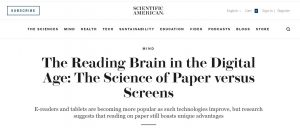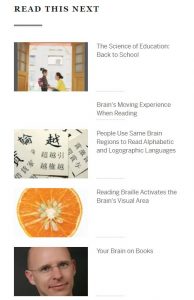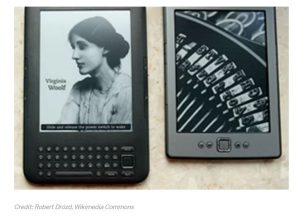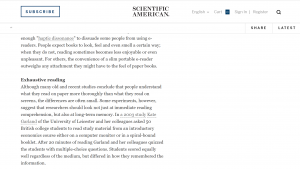 In Ferris Jabr’s article, “The Reading Brain in the Digital Age: The Science of Paper versus Screens”, he starts with a description of a video about a one-year old girl trying to use a magazine like an iPad. Starting the paper off like this shows how much technology has influenced our way of living. In his article, Jabr uses rhetoric to talk about how printed text and online reading are just about equal, but have differences. Ferris was a staff editor at the Scientific American which he is now just a contributing writer. He has also written for The New York Times, Outside, TheNewYorker.com, Slate, Wired, and many more. He has an MA in journalism from New York University and a Bachelors of Science from Tufts University. With his background in writing, I would believe him to be a credible source for this article; he has a background in science and a lot of experience in writing. He’s written for big, well known writing companies, which would make him pretty reliable.
In Ferris Jabr’s article, “The Reading Brain in the Digital Age: The Science of Paper versus Screens”, he starts with a description of a video about a one-year old girl trying to use a magazine like an iPad. Starting the paper off like this shows how much technology has influenced our way of living. In his article, Jabr uses rhetoric to talk about how printed text and online reading are just about equal, but have differences. Ferris was a staff editor at the Scientific American which he is now just a contributing writer. He has also written for The New York Times, Outside, TheNewYorker.com, Slate, Wired, and many more. He has an MA in journalism from New York University and a Bachelors of Science from Tufts University. With his background in writing, I would believe him to be a credible source for this article; he has a background in science and a lot of experience in writing. He’s written for big, well known writing companies, which would make him pretty reliable.
Jabr’s audience are those interested in science, as he published this article on the Scientific American. He uses many experimental studies as evidence; studies that include college students in science. Primary audience would includes those who study science from about 19-30. Also, those who have at least graduated high school. This article includes a lot of vocabulary that someone in middle school probably wouldn’t be able to understand and involves a lot of studies and experiments from colleges. His secondary audience would be those who have an interest in science that are older and want to keep up to date on science things that do have some sort of background education in science.
The purpose of his article is to show the main differences between print texts and online texts. He includes studies that include different online and print texts where they then have to recall information form each. Differences in each would include navigation through the texts, distractions, etc. “Mangen thinks that students reading pdf files had a more difficult time finding particular information when referencing the texts,” (qtd. in Jabr). “Surveys indicate that screens and e-readers interfere with two other aspects of navigating texts: serendipity and a sense of control.” (Fabr, “The Reading Brain in the Digital Age: The Science of Paper versus Screens) At the very end of his article he says, “ When it cones to intensively reading long pieces of plain text, paper and ink may still have the advantage. But text is not the only way to read.” (Jabr, “The Reading Brain in the Digital Age: The Science of Paper versus Screens”).
His context of this article would include on the internet in Scientific American. Someone would read this for an assignment in school possibly for a science or literature class. Someone would also possibly want to read this if they wanted to research the differences between reading online and reading a paper version of a text. Someone else who might read this could just be curious about reading. Also, If I were someone who were to enjoy reading and wanted to see if reading online or a book was better.
His genre includes using hyperlinks to studies and important people. It’s in the Scientific American which can be found online on their website. There’s not very many pictures except for one which is a picture of two
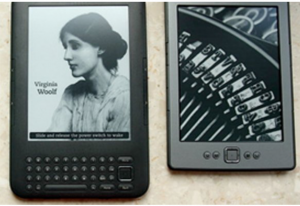 ebook readers. He uses little subtitles to give an idea of what the next paragraph talks about; these include ‘Exhaustive Reading’, ‘Navigating Textual Landscapes’ and ‘Attitude Adjustments’. There’s also information about the author at the end and other works of his as well. Under the title of the article is a little sentence that gives an idea of what the article is about. There are some italics that are for the name of other texts and quotations as well. You can also share this article, which can be found at the top of the page in black and somewhat bold letters. You can also subscribe to the Scientific American which is found in a navy blue to grab your attention to get you to subscribe.
ebook readers. He uses little subtitles to give an idea of what the next paragraph talks about; these include ‘Exhaustive Reading’, ‘Navigating Textual Landscapes’ and ‘Attitude Adjustments’. There’s also information about the author at the end and other works of his as well. Under the title of the article is a little sentence that gives an idea of what the article is about. There are some italics that are for the name of other texts and quotations as well. You can also share this article, which can be found at the top of the page in black and somewhat bold letters. You can also subscribe to the Scientific American which is found in a navy blue to grab your attention to get you to subscribe.
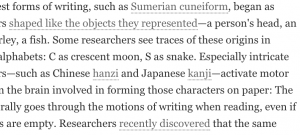
In his article, he doesn’t use much color, even the main focus of the picture is in black and white (Robert Drodz, Wikimedia Commons). The hyperlinks are in grey. His subtitles are in black and a little larger font so you can see what the next coming paragraphs are about. There are some other articles at the top of the page next to his first couple of paragraphs that kind of draw your attention to them. These articles can also be found at the bottom of the page at the end of the article.
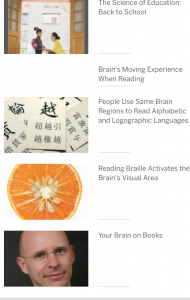
Jabr’s use of rhetoric helps to persuade you to see his view on this topic. He uses a lot little subtle things to grab your attention and take his side on this discussion. Whether it be small or somewhat noticing, Jabr uses good rhetoric in his article.



